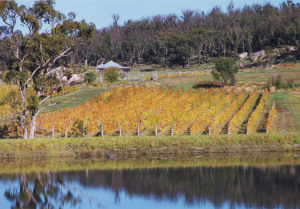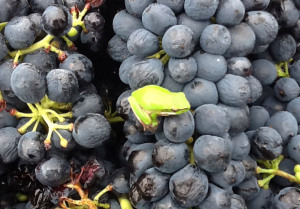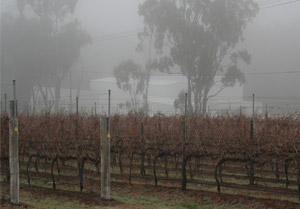
We proudly only use environmentally friendly chemicals on our vineyard and so were delighted to find this little fellow accidentally picked from our Shiraz block whilst hanging onto a bunch of grapes. He was released back to his home in the vineyard after the 2014 vintage was picked.
The key to Symphony Hill’s success in producing super premium wines of unique style and flavour lies in the vineyard. The factors that contribute to our success are as follows:
Control of Water to Vine Roots
Control of plant available water is essential in growing quality fruit. During the growing season there are periods where the vine must not struggle to find water, whereas during ripening (or ‘veraison’) a little bit of water stress will promote higher quality fruit.
Major earthworks were undertaken pre-planting to create headlands and waterways which divert water run-off away from each vineyard block. Sub-surface drainage was installed in each block so as to increase the speed that rainfall which percolates through the soil will run out the drains. The soils are very sandy and so have excellent drainage properties. In addition all vine rows are hilled up and the grassed mid-rows have a slight ‘V’ shape. This combination helps in diverting rainfall away from the vines to the middle of each row and then down the rows out of the vineyard. The result is that we can control the amount of water that reaches the vine roots through drip irrigation.
Soil moisture is monitored closely and accurately with capacitance probes through the growing season. It is essential to induce mild water stress to the vines between fruit set and veraison. It is during this period that cell division occurs. If you slow down this division due to water stress, then less cells will divide and smaller berries will be the result. This leads to concentrated flavours and higher skin to flesh ratio. With red wines, all of the colour and much flavour comes from the skin.
Our Soil
Our soils are a result of granite boulders decomposing over thousands of years. The soil consists of the following layers as you travel down through the profile: sand, loamy sandy, sandy loam. There is very little clay content. These soil types provide excellent drainage which is essential for quality wine grape growing. The soils are nutritionally poor and require inputs during the growing season. We have been successfully working each year on improving the soil structure and thus improving its ability to store nutrients with increased organic matter content.
Considerable effort went into improving our soil pre-planting. Jumbo Sorghum grass was grown in the summer and canola in the winter. These crops were disced into the ground at the end of each season. This had the benefits of improving soil structure, increasing organic matter levels and reducing nematode populations.
Our vine mid-rows are grassed with many different types of grasses and legumes. We mow every alternate mid-row, so as to keep the grass in every second row high and flowering. This has a wonderful effect of increasing the diversity and numbers of beneficial insect populations. Beneficial insects are those that feed on the insects that can damage the vines’ leaves, shoots and fruit. This removes the need to spray insecticides.
We maintain a thick covering of sugar cane mulch along each vine row. Mulching is wonderful!! Mulch keeps the soil under each vine at a constant cool temperature, dramatically reduces the amount of water that evaporates from the soil, allows microbes, insects and worms to thrive in the top soil and thus dramatically improve the soil structure and organic matter content.
Soil tests are performed each winter to gauge our nutrient requirements for the season ahead and to monitor our soil improvements each year. A manure compost is broadcast throughout the vineyard before Spring to assist the vines and mid row grasses to thrive once Spring arrives.
Our Climate
The climate is unmatched elsewhere in Australia due to an elevation of around 1000 metres. We are classified as a cool climate wine growing region. The climate is well suited to most cool climate varieties and ripening is reliable, provided the fruit is exposed to light and there is no over cropping.
The cool climate vineyard experiences four distinct seasons each year. Our winter temperatures drop below –10°C and our mean maximum January temperature is only 26°C and our mean minimum January temperature is only 14°C. Warm days and cool nights are essential to build complex flavours in the grape berries.
Control of Water to Vine Roots
Control of plant available water is essential in growing quality fruit. During the growing season there are periods where the vine must not struggle to find water, whereas during ripening (or ‘veraison’) a little bit of water stress will promote higher quality fruit.
Major earthworks were undertaken pre-planting to create headlands and waterways which divert water run-off away from each vineyard block. Sub-surface drainage was installed in each block so as to increase the speed that rainfall which percolates through the soil will run out the drains. The soils are very sandy and so have excellent drainage properties. In addition all vine rows are hilled up and the grassed mid-rows have a slight ‘V’ shape. This combination helps in diverting rainfall away from the vines to the middle of each row and then down the rows out of the vineyard. The result is that we can control the amount of water that reaches the vine roots through drip irrigation.
Soil moisture is monitored closely and accurately with capacitance probes through the growing season. It is essential to induce mild water stress to the vines between fruit set and veraison. It is during this period that cell division occurs. If you slow down this division due to water stress, then less cells will divide and smaller berries will be the result. This leads to concentrated flavours and higher skin to flesh ratio. With red wines, all of the colour and much flavour comes from the skin.
Research and Development Projects
We will never be accused of resting on our laurels. Latest theories in viticulture are examined for whether they would be beneficial to our vineyard. Some of the research work undertaken consists of partial rootzone drying, use of worm compost under the mulch to improve grape quality, and analysing the benefits of green compost waste as mulch.
Future research projects will incorporate introduction of large flat river rocks as mulch along the vine rows in areas of frost susceptibility to assist in frost protection. Traditional vegetative mulch techniques improve soil structure however cause worse damage should a frost hit as heat from the soil can not pass through the mulch at night to protect against frosts. It is envisaged that river rocks will provide the same benefits to soil structure as traditional mulch but with the added benefit of radiating heat into the vine canopy at night during frost conditions.

Our Shiraz block

We proudly only use environmentally friendly chemicals on our vineyard and so were delighted to find this little fellow accidentally picked from our Shiraz block whilst hanging onto a bunch of grapes. He was released back to his home in the vineyard after the 2014 vintage was picked.

Our Cabernet Sauvignon block in heavy fog
